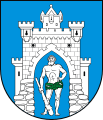Prabuty
| Prabuty | |||
|---|---|---|---|
|
Cathedral in Prabuty (1st half of 14th century) | |||
| |||
 Prabuty | |||
| Coordinates: 53°45′21″N 19°11′51″E / 53.75583°N 19.19750°ECoordinates: 53°45′21″N 19°11′51″E / 53.75583°N 19.19750°E | |||
| Country |
| ||
| Voivodeship | Pomeranian | ||
| County | Kwidzyn | ||
| Gmina | Prabuty | ||
| Town rights | 1330 | ||
| Government | |||
| • Mayor | Bogdan Józef Pawłowski | ||
| Area | |||
| • Total | 7.92 km2 (3.06 sq mi) | ||
| Elevation | 90 m (300 ft) | ||
| Population (2006) | |||
| • Total | 8,488 | ||
| • Density | 1,100/km2 (2,800/sq mi) | ||
| Time zone | CET (UTC+1) | ||
| • Summer (DST) | CEST (UTC+2) | ||
| Postal code | 82–550 | ||
| Area code(s) | +48 55 | ||
| Car plates | GKW | ||
| Website | http://www.prabuty.pl | ||
Prabuty [praˈbutɨ] (German: Riesenburg) is a town in Kwidzyn County within the Pomeranian Voivodeship of northern Poland. In the period between 1975–98 Prabuty were part of the Elbląg Voivodeship.
Geographical location
Prabuty is located approximately 18 kilometers east of Kwidzyn, 100 kilometers south-east of Gdańsk, 100 kilometers west of Olsztyn and 133 kilometers south-west of Kaliningrad.
Prabuty is an important rail junction on the Warszawa–Gdynia railway.
History
In 1236, the Teutonic Knights under Henry III, Margrave of Meissen, destroyed an Old Prussian fortress between the lakes Sorgensee[1] (jez. Dzierzgon) and Liwieniec. The town was first mentioned in 1250 as Riesenburg. The village growing around the castle and received Culm law city rights on 30 October 1330[2] from bishop Rudolf of Pomesania (1322–1332).
In 1451 the town council joined the Prussian Confederation that opposed the Teutonic Order, but bishop Kaspar Linke expelled the councilors and confiscated their property. After the Battle of Chojnice, in which Polish forces were defeated, the town sided with the Order again.
After the Thirteen Years' War and the Second Peace of Thorn (1466) the town became part of Ducal Prussia although Pomesanian bishops retained their rule over the area. A synod was held in the town in 1556.
Riesenburg suffered during the 17th century Polish-Swedish wars. In 1628 half of it burnt down, and in 1688 it burnt down completely.[3] In 1722 fire caused great destructions.[3]
In 1701,as part of Ducal Prussia, the town became a part of the Kingdom of Prussia and part of the newly created province of West Prussia in 1772. In 1871 the town became part of the German Empire in the framework of the Prussian-led unification of Germany. Until 1919 Riesenburg belonged to the administrative district of Regierungsbezirk Marienwerder in the Province of West Prussia.
After World War I, a referendum was held concerning the future nationality of the town, which remained part of Weimar Germany. From 1920 to 1939 Riesenburg belonged to the administrative district of Regierungsbezirk Westpreußen in the Province of East Prussia and from October 26, 1939, to 1945 to the district Regierungsbezirk Marienwerder in the province of Reichsgau Danzig-West Prussia.
The town was captured by the Soviet Red Army in 1945 during World War II. It then became part of Poland. Most of the native East-Prussian inhabitants were expelled and replaced by Poles from regions east of the Curzon Line, in particular from the former Polish Kresy Wschodnie.
Heinz Heydrich (1905–44, suicide), brother of Reinhard Heydrich, is buried in a soldiers cemetery Riesenburg, according to the Deutsche Dienststelle (WASt).
Number of inhabitants by year
| Year | Number |
|---|---|
| 1777 | 1,797 |
| 1782 | 1,878 |
| 1831 | 2,722 |
| 1875 | 3,542 |
| 1880 | 3,718 |
| 1890 | 4,586 |
| 1900 | 5,032 |
| 1905 | 4,826 |
| 1925 | 5,340 |
| 1933 | 6,116 |
| 1939 | 8,093 |
| 2006 | 8,488 |
Notable residents
- Peter I, Grand Duke of Oldenburg (1755–1829)
- Adolf Treichel (1869–1926), German politician, President of the Volkstag (Free City of Danzig)
- Ernst Kuss (1886–1956), German politician
- Charlotte Wolff (1897–1986), German-British scientist
- Heino Falcke (born 1929), German Protestant theologian
- Hartwig Reimann (born 1938), German politician
- Karl Friedrich Masuhr (born 1939), German author
- Harald Dzubilla (born 1944), German journalist
References
- ↑ ostpreussen.net Geschichte von Prabuty – Riesenburg
- ↑ "History of Prabuty".
- 1 2 3 Johann Friedrich Goldbeck: Volständige Topographie des Königreichs Preussen. Part II: Topographie von West-Preussen, Marienwerder 1789, p. 6, no 2.
- ↑ Meyers Großes Konversations-Lexikon, 6th edition, Vol. 16, Leipzig 1909, pp. 925–926.
- ↑ Michael Rademacher: Deutsche Verwaltungsgeschichte Provinz Westpreußen, Kreis Rosenberg (2006).
- ↑ August Eduard Preuß: Preußische Landes- und Volkskunde. Königsberg 1835, p. 441.
External links
- Municipal website (in Polish)
- Independent Municipal Website (in Polish)
- History and Forum City (in Polish)
- Futbol Team Website (in Polish)


